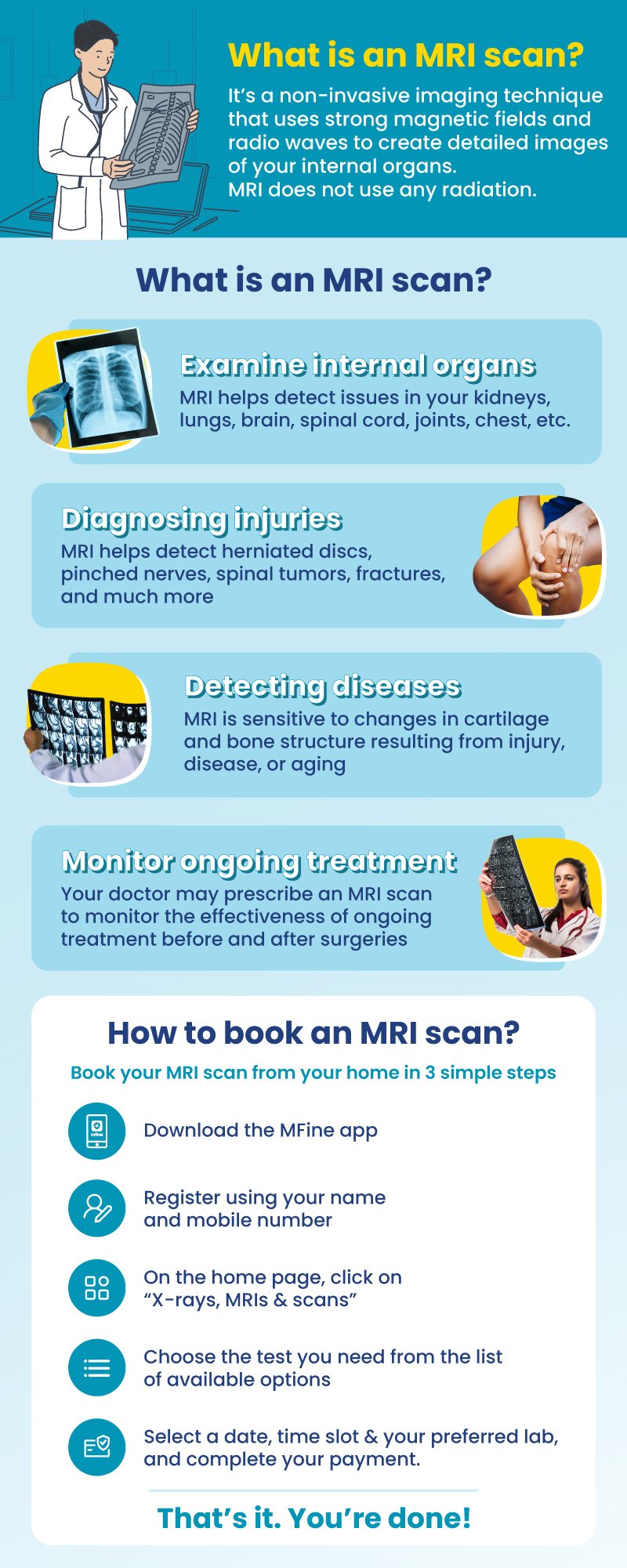
Get great discounts on Spine MRI scans in Chennai without compromising on quality. Limited-time offer—Book now!
MFine offers you high-quality lab options, and an excellent discount of upto 50%, for your MRI Spine in Chennai.
|
MRI Scan Spine In Chennai By MFine
|
In Chennai, the typical cost of a Spine MRI is over ₹6,500. Fortunately, we have a special deal available that can provide significant savings. For a limited period, you can have the scan performed for only ₹2,900. This offer can save you as much as upto 50%!
Take control of your health with this incredible opportunity. Request a callback by clicking the button below or calling now. Don’t miss out!
Our team is ready and available to provide assistance with any inquiries you might have.
When you book your Spine MRI scan with us, you’ll get also get a FREE online consultation with a doctor. Save on the scan cost and gain valuable medical insights. Act now and make the most of this exclusive offer!
Spine MRI scan costs in Chennai
Discover the popular Brain MRI scans offered in Chennai and their discounted rates provided below. Keep in mind that prices are subject to change, so get in touch with us for the most up-to-date details.
| MRI Scan Spine Cost In Chennai | Offer Price |
| MRI Whole Spine Price in Chennai | ₹5950 |
| MRI Cervical Spine Price in Chennai | ₹2900 |
| MRI Dorsal Spine Price in Chennai | ₹2900 |
| MRI Lumbar Spine Price in Chennai | ₹2900 |
If you need additional information, feel free to reach out to us at ☏08068172507.
|
Why Should I Book MRI Through MFine?
|
Exclusive Benefits with MFine
(1) Certified labs
Get access to over 600+ labs certified by NABL and NABH
(2) Same-day slot available
Get scans done on the same day
(3) Quick and convenient
Get reports in 12 hours and digital films in 15 – 20 minutes
(4) FREE Consultation
Post scans, consult a doctor for free to review your report
MRI of the Spine
The human spine, a remarkable and intricate structure, is composed of various components that collectively provide stability, flexibility, and protection to the delicate spinal cord and nerves. Let’s delve into the different parts that make up this vital backbone of our body and understand their roles in maintaining our overall well-being.
(1) Vertebrae: The human spine is comprised of 33 small bones called vertebrae, arranged one on top of the other, forming a column-like structure.
These vertebrae serve as the foundational building blocks of the spine, providing support and structure to the body.
They are strategically designed to protect the spinal cord and nerves, safeguarding them from potential injuries or trauma.
(2) Facet Joints: Positioned on both sides of the spine, facet joints are small synovial joints located between adjacent vertebrae.
These joints play a crucial role in the spine’s flexibility, allowing it to bend, rotate, and extend smoothly.
Lined with cartilage and containing synovial fluid, they minimize friction during spinal movements, promoting fluid motion.
Dysfunction or degeneration of facet joints can lead to back pain and other spinal issues, impacting an individual’s mobility and comfort.
(3) Intervertebral Disks: Intervertebral disks, often likened to flat, round cushions, are situated between the bones of the spine.
These disks serve as shock absorbers, effectively cushioning the vertebrae and minimizing impact during daily activities.
Each disk consists of a soft, jelly-like center called the nucleus pulposus, surrounded by a durable, flexible outer ring known as the annulus.
These disks are constantly under pressure due to gravitational forces and the movements of the spine.
In some cases, a disk may tear, leading to the leakage of the jelly-like substance and causing pain and discomfort. This condition is referred to as a herniated disk.
(4) Spinal Cord and Nerves: The spinal cord, a vital part of the central nervous system, extends from the brainstem to the lower back within the protective vertebral column.
It consists of a bundle of nerves that transmit sensory and motor signals between the brain and the rest of the body.
The spinal cord contains 31 pairs of spinal nerves that emerge through openings in the spine, known as neural foramina.
These nerves play a pivotal role in carrying messages between the brain and muscles, enabling voluntary movements and sensory perception.
(5) Soft Tissues: Ligaments, similar to ropes, serve as connective tissue holding the vertebrae together, ensuring proper alignment and stability of the spine.
Muscles, strategically located along the length of the spine, provide essential support to the back and enable various movements.
Tendons, akin to strong bands, connect muscles to bones, facilitating smooth and coordinated movements.

What are the different spine segments?
The different spine segments include:
- Cervical (neck): Comprises the top 7 vertebrae, labeled as C1 to C7, supporting neck movements and protecting vital nerves.
- Thoracic (middle back): Consists of 12 chest or thoracic vertebrae, numbered as T1 to T12, providing stability and anchoring the ribcage.
- Lumbar (lower back): Encompasses 5 vertebrae, identified as L1 to L5, supporting the lower back and bearing significant body weight.
- Sacrum: A triangular bone connecting to the hip bones, formed by the fusion of five sacral vertebrae (S1 to S5).
- Coccyx (tailbone): The small bone located at the base of the spine, comprising the coccygeal vertebrae.
Which disorders can be diagnosed using a spine MRI?
A spine MRI is an invaluable diagnostic tool capable of identifying various conditions, including:
- Arthritis (ankylosing spondylitis)
- Back strains and sprains
- Birth defects (spina bifida)
- Bone spurs
- Curvatures of the spine (scoliosis and kyphosis)
- Neuromuscular diseases (ALS)
- Nerve injuries (spinal stenosis, sciatica, pinched nerves)
- Osteoporosis (weak bones)
- Spinal cord injuries (fractures, herniated disks, paralysis)
- Spine tumors and cancer
- Spine infections (meningitis, osteomyelitis)
Why would a doctor prescribe a spine MRI?
A doctor may prescribe a spine MRI for the following reasons:
- To diagnose and evaluate spinal conditions such as arthritis, bone spurs, and curvatures (scoliosis, kyphosis).
- To assess and monitor back injuries like strains, sprains, and fractures.
- To investigate nerve-related issues such as spinal stenosis, sciatica, and pinched nerves.
- To detect and evaluate spinal cord injuries, herniated disks, and tumors.
- To diagnose infections like meningitis and osteomyelitis affecting the spine.
FAQs
Is MRI good for the spine?
Yes, MRI (Magnetic Resonance Imaging) is an excellent imaging modality for evaluating the spine. It provides detailed images of the spinal structures, including the discs, nerves, vertebrae, and surrounding tissues, helping doctors diagnose various spinal conditions and injuries.
Can MRI show nerve damage?
Yes, MRI can show nerve damage in certain cases. MRI is capable of visualizing soft tissues, including nerves. It can help detect nerve compression, inflammation, or other abnormalities that may be causing nerve damage.
Can MRI detect back pain?
Yes, MRI can help identify the cause of back pain. It is commonly used to assess various spinal conditions such as herniated discs, spinal stenosis, degenerative changes, tumors, and infections, which can be potential sources of back pain.
What if MRI is normal but still in pain?
If an MRI is normal, but the person is still experiencing pain, it means that the MRI did not detect any significant structural abnormalities that could explain the pain. In such cases, the doctor may consider other factors like muscle strain, ligamentous injuries, or functional issues that may not be visible on MRI.
Which is better for back pain, MRI or CT scan?
For most cases of non-traumatic back pain, MRI is generally considered better than a CT scan. MRI provides more detailed images of soft tissues, including discs, nerves, and ligaments, making it more suitable for evaluating the cause of back pain. CT scan is usually reserved for specific cases where bony structures need to be assessed, such as fractures or spinal tumors.
Read a complete blog on which is better: An MRI or CT Scan?
Can MRI detect hormonal imbalance?
No, MRI cannot directly detect hormonal imbalances. Hormonal imbalances are diagnosed through blood tests and other specialized tests. MRI is primarily used for imaging structures like organs, bones, and soft tissues.
What are the side effects of an MRI spine?
MRI is considered safe and non-invasive. It does not use ionizing radiation like X-rays or CT scans. However, there are some potential side effects, although rare, such as:
- Claustrophobia due to the enclosed space inside the MRI machine.
- Allergic reactions to contrast agents (if used).
- Interference with implanted medical devices (e.g., pacemakers or metal implants).
Read a complete blog on MRI scan side effects.
Can MRI pick up PCOS?
No, MRI is not typically used to diagnose Polycystic Ovary Syndrome (PCOS). PCOS is usually diagnosed based on clinical symptoms, blood tests to check hormone levels and ultrasound imaging of the ovaries. MRI is not the standard imaging method for PCOS diagnosis.
Can you see ovarian cysts in MRI?
Yes, ovarian cysts can be seen in MRI scans. MRI can provide detailed images of the pelvis and abdominal area, allowing doctors to visualize ovarian cysts and assess their characteristics, size, and location. MRI is particularly useful when the cyst’s nature needs to be determined for treatment planning.
Other topics you may be interested in
| For further assistance call us on ☏08068172507 |

 Call us:
Call us:


 Call
Now
Call
Now